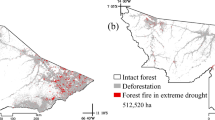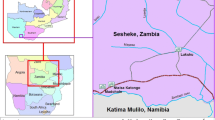Abstract
To elucidate the expansion of bamboo (Phyllostachys pubescens Mazel ex Houzeau de Lehaie) forests, we used multiple linear regression analysis and determined whether there were site differences for data obtained in Hirasawa, Otaki-machi, Chiba Prefecture, and Kofuki, Takehara City, Hiroshima Prefecture, Japan. Vegetation maps from 1984 and 2001 for Hirasawa, and from 1986, 1996, 2000, and 2006 for Kofuki, were compared, and the annual expansion rate of each P. pubescens forest was calculated. We evaluated nine indices, including original bamboo forest area, neighbouring vegetation, slope inclination and aspect, distance from roads, and shipment of bamboo shoots. Shipment of bamboo shoots was a positive factor for P. pubescens forest expansion, whereas the proportion of adjacent short vegetation, northness (the cosine of slope aspect), and area negatively affected the expansion in Hirasawa (R 2 = 0.683). On the other hand, distance from roads and eastness (the sine of slope aspect) positively affected expansion, while slope inclination was a negative factor in Kofuki (R 2 = 0.942). We calculated that P. pubescens forests expanded at about 2% per year in regions of reduced shipments of bamboo-shoot harvest. We showed that not only natural conditions but also management factors affect P. pubescens forest expansion. Regional differences in natural and anthropogenic effects on expansion were also found.




Similar content being viewed by others
References
Chiba Prefecture (1976) Basis survey of land classification, Otaki. Chiba Prefecture, Chiba
Fukamachi K, Oku H, Nakashizuka T (2001) The change of a satoyama landscape and its causality in Kamiseya, Kyoto Prefecture, Japan between 1970 and 1995. Landsc Ecol 16:703–717
Geological Survey of Japan (2004) Digital geological maps of Japan 1:200,000, Kanto-Koshinetsu and Izu-Ogasawara Islands. Geological Survey of Japan, Tsukuba
Geological Survey of Japan (2005) Digital geological maps of Japan 1:200,000, Eastern and central part of Chugoku, and Shikoku. Geological Survey of Japan, Tsukuba
Hiroshima Prefecture (1985) Basis survey of land classification, Takehara. Hiroshima Prefecture, Hiroshima
Isagi Y, Torii A (1998) Range expansion and its mechanisms in a naturalized bamboo species, Phyllostachys pubescens, in Japan. J Sustain For 6:127–141
Isagi Y, Kawahara T, Kamo K, Ito H (1997) Net production and carbon cycling in a bamboo Phyllostachys pubescens stand. Plant Ecol 130:41–52
Janzen DH (1976) Why bamboos wait so long to flower. Ann Rev Ecol Syst 7:347–391
Li R, During HJ, Werger MJA, Zhong ZC (1998a) Positioning of new shoots relative to adult shoots in groves of giant bamboo, Phyllostachys pubescens. Flora 193:315–321
Li R, Werger MJA, During HJ, Zhong ZC (1998b) Biennial variation in production of new shoots in groves of the giant bamboo Phyllostachys pubescens in Sichuan, China. Plant Ecol 135:103–112
Li R, Werger MJA, During HJ, Zhong ZC (1998c) Carbon and nutrient dynamics in relation to growth rhythm in the giant bamboo Phyllostachys pubescens. Plant Soil 201:113–123
Li R, Werger MJA, de Kroon H, During HJ, Zhong ZC (2000) Interactions between shoot age structure, nutrient availability and physiological integration in the giant bamboo Phyllostachys pubescens. Plant Biol 2:437–446
Lovett Doust L, Lovett Doust J (1982) The battle strategies of plant. New Scientist 8:81–84
Makita A (1998) The significance of the mode of clonal growth in the life history of bamboos. Plant Species Biol 13:85–92
Miyake N, Kawanishi M, Miyake M, Ishikawa S (2000) Expansion of bamboo forests in the Kitayama region, Koshi City, southwestern Japan: I, Change in the area of the bamboo forests during the last 30 years (in Japanese). Hikobia 13:241–252
Nishikawa R, Murakami T, Yoshida S, Mituda Y, Nagashima K, Mizoue N. (2005) Characteristic of temporal range shifts if bamboo stands according to adjacent landcover type (in Japanese). J Jpn For Soc 87:402–409
Ogura J (1988) The transition of bamboo forest in the suburbs of Kyoto in and after modern times (in Japanese). Kino-Hyoron Kyoto Seika Univ 19:25–41
Ohno T, Kaga H, Shimomura Y, Masuda N (2002a) A study of the relationship between bamboo forest and the surrounding land-use: case study in Kishiwada city, Osaka. Environ Info Sci 16:369–374
Ohno T, Kaga H, Shimomura Y, Masuda N (2002b) A study of the patterns of bamboo forest expansion in Kishiwada city, Osaka (in Japanese). J Jpn Inst Landsc 65:603–608
Ohno T, Kaga H, Shimomura Y, Masuda N (2003) Study of the relationship between the change in structure and the distance to a residential area of bamboo forests in Kishiwada city near Osaka in western Japan (in Japanese). J Jpn Inst Landsc 66:547–550
Ohno T, Shimomura Y, Maenaka H, Masuda N (2004) Study on the tradition and the prediction of the expansion of bamboo forests (in Japanese). J Jpn Inst Landsc 66:567–572
Okutomi K, Shinoda S, Fukuda H (1996) Causal analysis of the invasion of broad-leaved forest by bamboo in Japan. J Veg Sci 7:723–728
Olejniczak P (2001) Evolutionarily stable allocation to vegetative and sexual reproduction in plants. Oikos 95:156–160
Osumi K, Ikeda S, Okamoto T (2003) Vegetation patterns and their dependency on site conditions in the pre-industrial landscape of north-eastern Japan. Ecol Res 18:753–765
Ruiz-Pérez M, Fu M, Yang X, Belcher B (2001) Bamboo forestry in China: toward environmentally friendly expansion. J For 99(7):14–20
Swanson FJ, Kratz TK, Caine N, Woodmansee RG (1988) Landform effects on ecosystem patterns and processes. Bioscience 38:92–98
Torii A (1998) Estimation of range expansion rate of bamboo stands using aerial photographs—case study on Mt. Hachiman, Shiga Prefecture, and Mt. Otoko, Kyoto Prefecture, Japan (in Japanese). Jpn J Ecol 48:37–47
Torii A, Isagi Y (1997) Range expansion of bamboo species in southern areas of Kyoto Prefecture, Japan (in Japanese). Jpn J Ecol 47:31–41
Watanabe M, Ueda K, Manabe I, Akai T (1982) Flowering, seeding, germination, and flowering periodicity of Phyllostachys pubescens. J Jpn For Soc 64:107–111
Acknowledgements
We are indebted to Prof. Sadao Takaoka of Senshu University for suggestions regarding research techniques at Hirasawa. We thank Dr. Akira Kikuchi, Mr. Yoshikazu Isozaki, and Mr. Eutiquio de Leon Rotaquio, Jr., of Hiroshima University, for their help. We are also grateful to the residents of Hirasawa and Kofuki for the information provided during our interviews. Finally, we thank Dr. Louis R. Iverson of the United States Department of Agriculture Forest Service for his valuable comments on an earlier draft of the manuscript.
Author information
Authors and Affiliations
Corresponding author
About this article
Cite this article
Suzuki, S., Nakagoshi, N. Expansion of bamboo forests caused by reduced bamboo-shoot harvest under different natural and artificial conditions. Ecol Res 23, 641–647 (2008). https://doi.org/10.1007/s11284-007-0422-8
Received:
Accepted:
Published:
Issue Date:
DOI: https://doi.org/10.1007/s11284-007-0422-8




